Results 1 to 10 of 12
-
 BANNED BANNED BANNED
BANNED BANNED BANNED

- Join Date
- Sep 2015
- Posts
- 13,919
August 16th, 2019 12:59 PM #1
Bureau on Cultural Heritage-BARMM
2 oras ·
DARANGEN: Masterpiece of the Oral and Intangible Heritage of Humanity
"The Darangen is the longest recorded oral epic in the Philippines. It consist of many cycles of episodes relating to different heroes, foremost among them Bantugan, whose name means, "one who makes history." Through his heroic tales, the epic proves that early forms of government, culture, art, music, metal work and warrior arts were already in existence before the arrival of colonizers."
"KASAYSAYAN: Bahagi ng ating Nakaraan, Gabay sa Kinabukasan"
#NationalHistoryMonth2019
#BCHBARMM
-
 Tsikoteer
Tsikoteer

- Join Date
- Mar 2008
- Posts
- 52,729
-
August 17th, 2019 06:54 AM #3
It is actually sad that prior the spannish period, we dont have much written history.
I guess the spaniards purposely erased them.
Sent from my BLL-L22 using Tapatalk
-
 Tsikoteer
Tsikoteer

- Join Date
- Mar 2008
- Posts
- 52,729
August 17th, 2019 11:49 AM #4
-
 BANNED BANNED BANNED
BANNED BANNED BANNED

- Join Date
- Sep 2015
- Posts
- 13,919
February 5th, 2020 04:21 AM #5What Really Happened During the Battle of Manila? - James M. Scott Interview
continuation..Pursuits
How Manila Was Destroyed in a Bloody, Brutal Battle That Killed 100,000 Civilians
The destruction of Manila became an inevitable consequence of a lack of planning.
By Mario Alvaro Limos | Feb 12, 2019
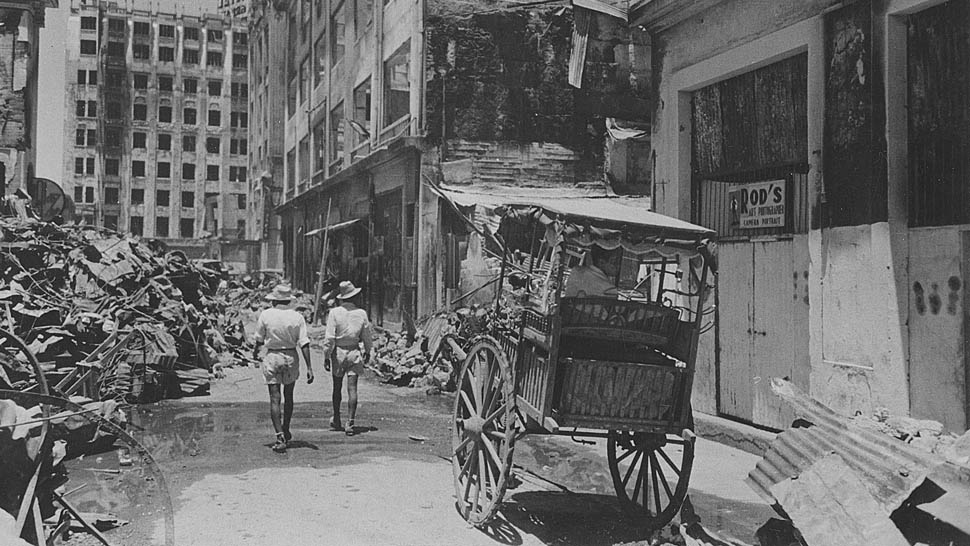
IMAGE WIKIMEDIA COMMONS/VICTOR JORGENSEN
In his book, Rampage: MacArthur, Yamashita, and the Battle of Manila, James M. Scott sheds light on General Douglas MacArthur’s ineptitudes in the liberation of Manila and the overwhelming atrocities committed by the Japanese during the Battle of Manila based on chilling first-hand accounts of Filipino and American survivors.
MacArthur Ignored Filipino Guerillas’ Reports
In 1942, just before the fall of Corregidor, General Douglas MacArthur escaped the besieged island by speedboat and was then flown from Mindanao to Australia with his family. Upon arriving on Australian soil, he immediately declared his famous line, “I came through and I shall return.”
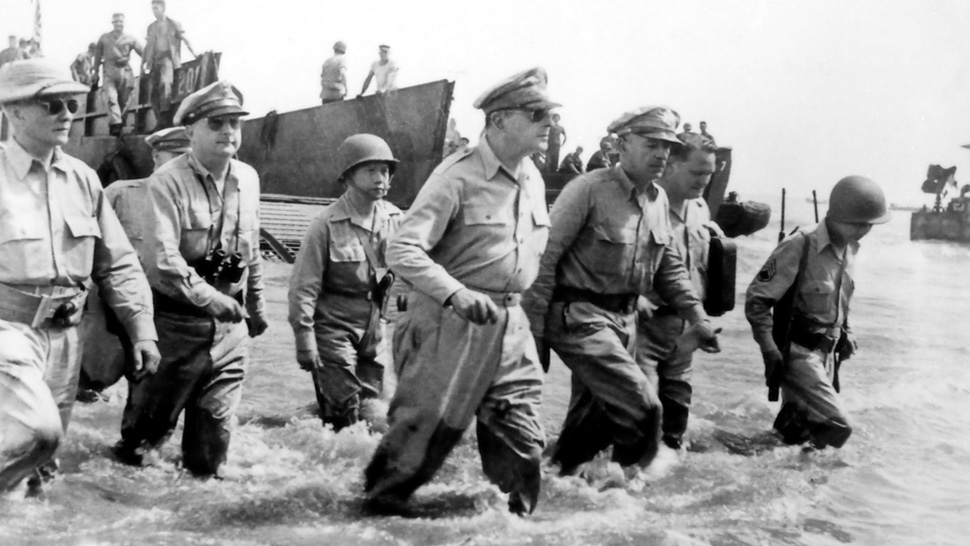
IMAGE WIKIMEDIA COMMONS/GAETANO FAILLACE
General MacArthur returns to the Philippines with Philippine President Sergio Osmeña to his right, Philippine Foreign Affairs Secretary Carlos P. Romulo at his rear, and Sutherland on his left. Photo taken by Gaetano Faillace
For MacArthur, these words meant more than a military objective—it was personal. “His father helped to capture Manila in the Spanish-American War,” says Scott in an interview with T&C. “He met his wife in Manila, their child was born in Manila, his mother had died here. Manila was the one place in his life where he found happiness, and the war took that all away from him, and he had to evacuate to Australia and leave his house hoping to return. He literally fights the rest of the war just to get back to Manila.”
“As a result of that obsession of coming back, he misreads some of the intelligence,” says Scott. “Filipino guerillas were reporting that the Japanese fortified the city. MacArthur disregarded that intelligence and trusted his own instincts. He’s convinced that the Japanese are going to do what he did with the city—evacuate Manila.”
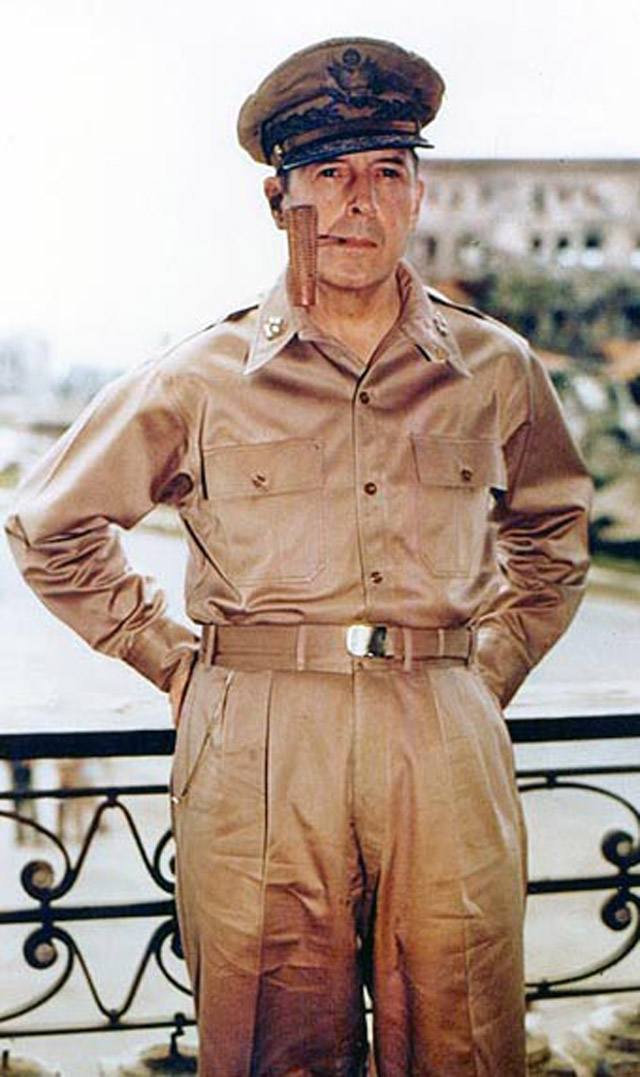
IMAGE WIKIMEDIA COMMONS/U.S. NATIONAL ARCHIVES
MacArthur in Manila, Philippines c. 1945, smoking a corncob pipe
MacArthur could not have thought more wrongly. Scott reveals in his book that while MacArthur was away planning for his liberation parade in Manila, the Japanese stayed put, fortified and barricaded all city blocks and intersections, created tunnels between buildings, put up soil walls inside many buildings, and booby-trapped corpses to slow the American advance. Their defense was so complex that it made it virtually impossible for Americans to recapture it.
“The hard part was the Americans knew very early on that the Japanese were not going to leave the city,” Scott says. “We had found Iwabuchi’s plan for the Battle of Manila. Once we had it translated, the intelligence analyst noted the fact that there was no plan of withdrawal, and so, this meant that this was going to be a fight to the death.”
Ironically, MacArthur’s commanding officers were hesitant to inform the general of the real situation in Manila for fear of bucking the general. It was only when MacArthur attempted to release a press report on his liberation parade that he discovered the truth.
“No, no, no, you can’t have a parade! The city is on fire!” relents a CBS Radio reporter to MacArthur, explains Scott. “It was a journalist who’s telling him what’s going on in the city—not his own generals.”
“That comes down to the way he ran his operation,” says Scott. “I also think that his senior commanders did not do a good enough job telling him how bad things were in the city until it was already well underway. He was kept in the dark.”
The Destruction of Manila
The destruction of Manila became an inevitable consequence of the lack of planning in the four months since MacArthur landed in Leyte despite numerous reports from Filipino guerillas and American intelligence. The Japanese were given a full four months of a head start in making Manila a city that cannot be captured.
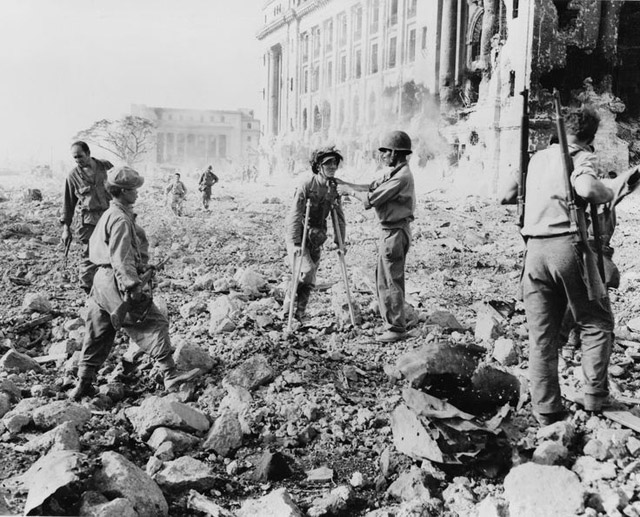
IMAGE WIKIMEDIA COMMONS/UNITED STATES LIBRARY OF CONGRESS
Japanese Imperial forces wounded surrender to US and Filipino soldiers under the United States Army and Philippine Commonwealth Army in an unidentified city in Manila, May 1945.
“The Japanese built tank traps in intersections, pillboxes, and fortified the insides of buildings, built staggered walls inside passageways to slow the Americans down,” Scott says. “It took a lot of firepowers to bring them out and destroy them.”
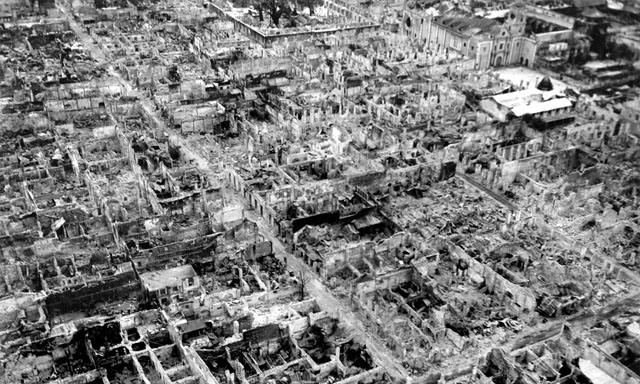
IMAGE WIKIMEDIA COMMONS
Destruction at the Walled City (Intramuros district) of old Manila in May 1945 — after the Battle of Manila
When it came to firepower, the Americans delivered.
“The American commanders at that time like Robert Beightler of the 37th Infantry said that his job was not to protect buildings, his job was to protect American troops,” Scott says. “It’s quite a callous thing to say, but as a new commander, he saw his job was to protect American troops. The city was really being destroyed from the inside by the Japanese, and from the outside by the Americans.”
This firepower, Scott admits, is the reason why thousands of civilians were killed. “In many accounts of the survivors in the book, there is no doubt that artillery played a role against a lot of people,” Scott says. “We fired 42,000 rounds of artillery in a matter of four weeks. You just can’t fire that much artillery into a city and not kill people.”
-
 BANNED BANNED BANNED
BANNED BANNED BANNED

- Join Date
- Sep 2015
- Posts
- 13,919
February 5th, 2020 04:33 AM #6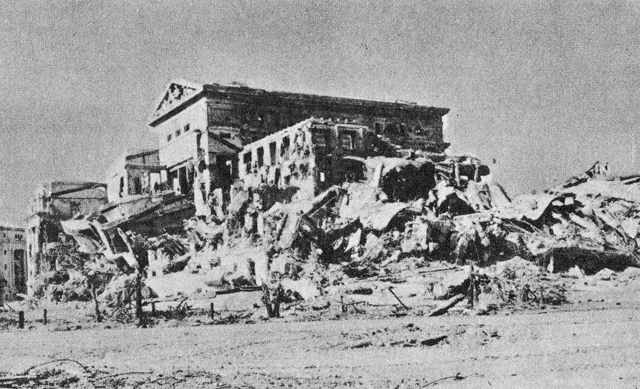
IMAGE WIKIMEDIA COMMONS/ROBERT ROSS SMIT
Destroyed Legislature Building, Manila, 1945
By the end of the month-long battle, Manila was reduced to nothing. “613 city blocks were destroyed—an area containing about 11,000 buildings: churches, banks, neighborhoods, houses,” explains Scott. “It was a battle that not only destroyed a lot of buildings, but it really destroyed a lot of heritage in Manila.”
Among the priceless heritage that were gutted or destroyed were museum paintings and sculptures, literary works in the archives, and records of the nation. Intramuros was reduced to rubble. Much of the structures in Intramuros we see today were only reconstructed after the war.
Other important heritage sites that were destroyed include the Manila City Hall, the Old Legislative Building (now the National Museum of Fine Arts), the Agriculture and Finance Buildings (now the National Museum of Anthropology and the National Museum of Natural History), and the Manila Central Post Office.
Human Casualties: The Greatest Loss
For Scott, the greatest tragedy in the Battle of Manila is the very high toll it took on its population. Asked about what he wants people to understand about Rampage, he explains its toll on people.
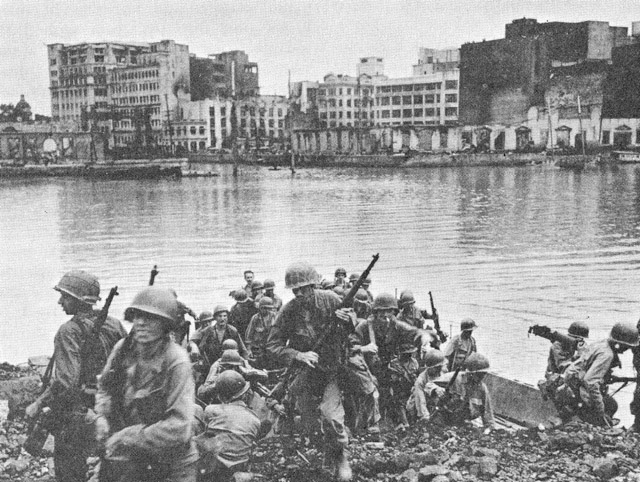
IMAGE WIKIMEDIA COMMONS/ROBERT ROSS SMIT
U.S. troops entering Walled City, Manila
“The Battle of Manila is a story unlike any other in the Pacific War. It is a very bloody urban war, but it’s also a civilian story—and it is a predominantly a civilian story,” explains Scott.
The author selected from tens of thousands of Filipino, American, and Japanese survivors’ unpublished testimonies and records from national archives and melded it all into one coherent storyline, shedding new light into the overwhelming, barbaric, and unbelievable depths that human cruelty could sink into.
“It is a battle that is borne literally on the backs of men, women, and children,” Scott laments. “I think that’s a really important thing for people to remember because ultimately, in this case, it’s the civilians who paid the largest price for the retaking of Manila.”
Scott explains that so many Filipinos—doctors, lawyers, judges, mothers, fathers, sons and daughters—were brutally killed. “These were the human capital that the soon-to-be independent Philippines in 1946 was going to have to stand on,” Scott says. “This is a battle that affected multiple generations and that’s all part of the tragedy, with repercussions felt up to today,” Scott reveals in his book.
The Most Haunting Experience
In his book, Scott zooms in on the experiences of those who survived the battle.
“It was totally haunting, I still get goosebumps talking about it now,” Scott confesses, referring to the time when he met a Filipino survivor of the Battle of Manila while doing research.
“It’s important that we tell the story now because there are survivors in the Battle of Manila who were children at the time, teenagers at the time, and now they’re in their 80s, and they remember! It’s so important that we get those stories now,” Scott explains.
“I met a Battle of Manila survivor, Jim, who said that ‘to really understand the Battle of Manila, you had to understand what my family went through.’”
“Jim took me on a tour. He showed me where a landmine had claimed one of their house helpers and injured their mother,” Scott recounts to T&C. “The family then scooped up his mother and had gone to PGH, so we also went to PGH. Jim and I got into the hospital and he took me into the hospital and he showed me the elevator where the elevator shaft had been. His family had gone down into that crawl space under PGH and waited for five days for the Americans. It was a totally haunting and chilling experience.”
Rampage consists of similar survivors’ first-hand accounts of the war. Scott raced to gather as many testimonies from survivors as possible.
“It’s important that we tell the story now because there are survivors in the Battle of Manila who were children at the time, teenagers at the time, and now they’re in their 80s, and they remember! It’s so important that we get those stories now,” Scott explains.
A Historic First
Rampage: MacArthur, Yamashita, and the Battle of Manila is the first American-authored book that deals on the subject.
“I was stunned to realize that there has never been an American book on the Battle of Manila,” shares Scott. “It stunned me that there has never been anything done on such a consequential story.”
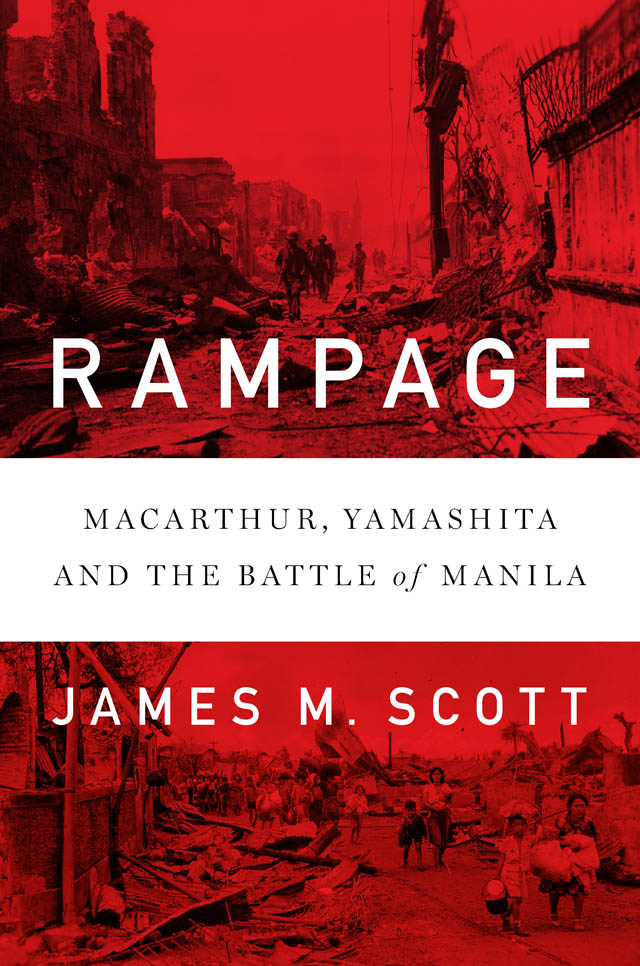
Rampage: MacArthur, Yamashita, and the Battle of Manila
nationalbookstore.com
P1,645.00
SHOP NOW
“It was the only urban battle in the Pacific War, it has widespread civilian deaths and atrocities, Manila is a place with very close relations with the United States, and had been Douglas MacArthur’s hometown before the battle took place,” Scott says. “There were all these elements that you would normally think would have jumped at any other writer to get, but it just fell through the cracks.”
The author selected from tens of thousands of Filipino, American, and Japanese survivors’ unpublished testimonies and records from national archives and melded it all into one coherent storyline, shedding new light into the overwhelming, barbaric, and unbelievable depths that human cruelty could sink into.
Rampage was officially launched in the Philippines on February 12, 2019 at the Ayala Museum in partnership with the Filipinas Heritage Library and the official distributor, National Book Store.
-
 Tsikoteer
Tsikoteer

- Join Date
- Mar 2008
- Posts
- 52,729
-
February 5th, 2020 12:42 PM #8
How I wish that history can be retold in such a way that you actually "live in the story", as being told, on each account that passes, as if it were happening in the very front of your eyes.
Without understanding why we raise our flag, the right to raise it, we can never be "enthusiastic" enough to care for our country. And no, I don't want to use the word "patriotic". Look how Luneta is right now, with that "tall building"...
-
 Verified Tsikot Member
Verified Tsikot Member

- Join Date
- Jun 2015
- Posts
- 2,751
February 5th, 2020 12:45 PM #9
-
 Tsikoteer
Tsikoteer

- Join Date
- Mar 2008
- Posts
- 52,729
February 5th, 2020 12:46 PM #10




 Reply With Quote
Reply With Quote






Yes Yes squeaking sound is heard when shifting only
Toyota Innova Owners & Discussions [continued...